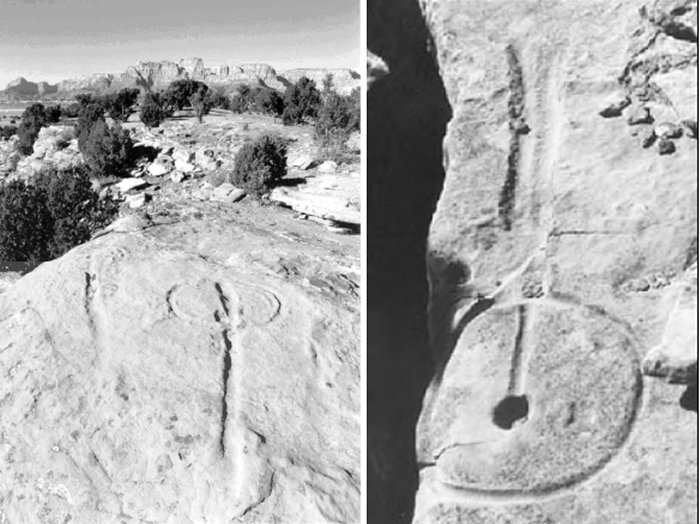Ellen Lloyd - AncientPages.com - More than 300 peculiar petroglyphs have been discovered scattered across the American Southwest. Most of these petroglyphs are known as water glyphs in northern Arizona, southern Utah, and Nevada.
Both images: Credit: Cody Spendlove, Wikipedia, CC BY-SA 4.0
Who created these mysterious petroglyphs, and for what purpose? There are some intriguing questions, but our knowledge of the water glyphs of North America remains incomplete.
To begin with, the age of the water glyphs has not yet been adequately determined. Using x-ray fluorescence, scientists suggest that the glyphs are about 2,000 years old. Still, they could be even older than that.
Water Glyphs Are Universal In Shape And Yet Slightly Different
Who the creators of the water glyphs were is also a question no one has been able to answer yet. Perhaps these enigmatic petroglyphs were produced by Ancestral Puebloans. This prehistoric Native American civilization occupied the present-day Four Corners region of the United States, i.e., the boundaries where Arizona, New Mexico, Colorado, and Utah intersect.
Left: Waterglyph in Mohave County, Arizona. Credit: Bob Ford - Right: Waterglyph from Kane County, Utah. Credit: Gordon Hutchings
The water glyphs were first discovered and documented by photographer Bob Ford in 1996.
After this discovery, Bob Ford became very interested in these ancient markings and visited hundreds of Native American sites to learn more about the water glyphs.
The water glyphs vary slightly in size but always have the same shape, circle, or ellipse bisected by a single straight line. They are usually 48 inches long by 24 inches wide, with grooves carved half an inch to an inch deep. Researchers noticed that although the basic glyph was universal in shape, there were often modifications to how the circle(s) were drawn. Ford and other scientists who examined the water glyphs think these variations were intended to convey meaning.
Deciphering The Meaning Of Water Glyphs
It has been suggested that the Anasazi civilization created water glyphs to show the direction of water sources. In a dry area where communities were far apart, there was a need to find water supplies, and these petroglyphs could have been used as directional signs.
Ford suggested the Anasazi designed the water glyphs to navigate through the Arizona desert. If this is the case, the water glyphs could be used as a modern map to navigate the desert. The water source was the most significant issue for the Anasazi; these navigation tools could help them avoid long walks and save time.
However, not everyone is convinced that water glyphs functioned as direction signs.
Some scholars think the mysterious ancient petroglyphs served as astronomical markers.
The Anasazi were a sophisticated civilization. They began as nomadic hunter-gatherers, perhaps as early as 1500 B.C. In time, they built great cities among the sandstone cliffs. The Anasazi astronomers studied the stars, and their engineers built significant roadways, towers, and stone complexes.
Supernova pictograph panel contains three symbols: a large star (supernova), a crescent moon, and a handprint. Source
The most common theory is that the glyphs of the American Southwest were used as a solstice marker. The Anasazi watched the skies and may have created the glyphs as solstice markers, or maybe they were some ancient calendar.
According to other theories, the glyphs were used to trap birds such as the eagle and the hawk so Indians could acquire the sacred feathers they needed for religious ceremonies. Yet another option is that the glyphs played an essential role in sacrificial altars, burial customs, or other important religious events practiced by the Anasazi.
Some think the glyphs could be writings left by the Spaniards. Perhaps the conquistadors needed directional markers to avoid getting lost in the desert.
At present, we do not know the purpose of the glyphs of the American Southwest, and unraveling their secrets requires more scientific studies. We are left with speculations about these enigmatic glyphs found in so many places across the American Southwest.
Written by Ellen Lloyd – AncientPages.com
Updated on October 30, 2023
Copyright © AncientPages.com All rights reserved. This material may not be published, broadcast, rewritten or redistributed in whole or part without the express written permission of AncientPages.com
Expand for references






